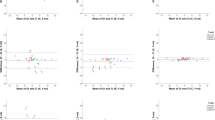Abstract
Objectives
Treatment outcomes are frequently evaluated based on the superimposition of digital dental models. However, errors from surface matching may distort these findings. The aims of this study were (i) to develop a simulation unit to mimic point set registrations and (ii) to evaluate the impact and clinical relevance of manual landmark selection errors on registration accuracy.
Material and methods
Ten randomly selected dental casts were digitized using a 3D laser scanner, and were loaded by an in-house developed simulation unit (MATLAB R2014a). First, the models were digitally duplicated and one surface was rotated and translated at random. Landmark-based registration was performed with 3 to 15 landmarks, and Gaussian noise was increased iteratively from 0 to 2 mm which simulated CP selection inaccuracy. Iterative closest point (ICP) matching was performed with and without addition of Gaussian noise. Finally, root-mean-squared (RMS) errors and Hausdorff distances were calculated, and averaged for each matching algorithm and noise level.
Results
Selection of 10 control points provided reliable registration even in the presence of noise. ICP improved registration results, but noise above 0.5 mm clearly worsened the outcomes.
Conclusion
Reliable superimposition of digital dental models is possible if 10 carefully selected control points with deviation below 0.5 mm are used for initial landmark-based registration.
Clinical relevance
Potential registration errors should be considered carefully whenever superimposed digital dental models are interpreted.











Similar content being viewed by others
References
Clements LW et al (2008) Robust surface registration using salient anatomical features for image-guided liver surgery: algorithm and validation. Med Phys 35(6):2528–2540
Toth R, Sperling D, Madabhushi A (2016) Quantifying post-laser ablation prostate therapy changes on MRI via a domain-specific biomechanical model: preliminary findings. PLoS One 11(4):e0150016
Besl PJ, McKay HD (1992) A method for registration of 3-D shapes. IEEE Trans Pattern Anal Mach Intell 14(2):239–256
Gruen A, Akca D (2005) Least squares 3D surface and curve matching. ISPRS J Photogramm Remote Sens 59(3):151–174
Al-Saleh MA et al (2016) MRI and CBCT image registration of temporomandibular joint: a systematic review. J Otolaryngol Head Neck Surg 45(1):30
Koerich L et al (2016) Three-dimensional maxillary and mandibular regional superimposition using cone beam computed tomography: a validation study. Int J Oral Maxillofac Surg 45(5):662–669
Seo YJ et al (2015) Effects of condylar head surface changes on mandibular position in patients with temporomandibular joint osteoarthritis. J Craniomaxillofac Surg 43(8):1380–1383
Garino F, Garino GB (2004) Distalization of maxillary molars using the speed system: a clinical and radiological evaluation. World J Orthod 5(4):317–323
Nienkemper M et al (2015) Effectiveness of maxillary protraction using a hybrid hyrax-facemask combination: a controlled clinical study. Angle Orthod 85(5):764–770
Zhang XJ et al (2015) Integrated three-dimensional digital assessment of accuracy of anterior tooth movement using clear aligners. Korean J Orthod 45(6):275–281
Ashmore JL et al (2002) A 3-dimensional analysis of molar movement during headgear treatment. Am J Orthod Dentofac Orthop 121(1):18–29 discussion 29-30
Müller-Hartwich R, Jost-Brinkmann P-G, Schubert K (2016) Precision of implementing virtual setups for orthodontic treatment using CAD/CAM-fabricated custom archwires. J Orofac Orthop / Fortschr Kieferortho 77(1):1–8
Almeida MA et al (1995) Stability of the palatal rugae as landmarks for analysis of dental casts. Angle Orthod 65(1):43–48
Peavy DC Jr, Kendrick GS (1967) The effects of tooth movement on the palatine rugae. J Prosthet Dent 18(6):536–542
Hoggan BR, Sadowsky C (2001) The use of palatal rugae for the assessment of anteroposterior tooth movements. Am J Orthod Dentofac Orthop 119(5):482–488
Jang I et al (2009) A novel method for the assessment of three-dimensional tooth movement during orthodontic treatment. Angle Orthod 79(3):447–453
Okatani IS, Deguchi K (2002) A method for fine registration of multiple view range images considering the measurement error properties. Comput Vis Image Underst 87(1–3):66–77
Park, S.Y. and S. Murali. A fast point-to-tangent plane technique for multi-view registration. in 3-D Digital Imaging and Modeling, 2003. 3DIM 2003. Proceedings. Fourth International Conference on. 2003.
Gan N, Xiong Y, Jiao T (2016) Accuracy of intraoral digital impressions for whole upper jaws, including full dentitions and palatal soft tissues. PLoS One 11(7):e0158800
Koch GK, Gallucci GO, Lee SJ (2016) Accuracy in the digital workflow: from data acquisition to the digitally milled cast. J Prosthet Dent 115(6):749–754
Choi DS et al (2010) Accuracy and reliability of palatal superimposition of three-dimensional digital models. Angle Orthod 80(4):497–503
Schmitt CM et al (2016) Soft tissue volume alterations after connective tissue grafting at teeth: the subepithelial autologous connective tissue graft versus a porcine collagen matrix—a pre-clinical volumetric analysis. J Clin Periodontol 43(7):609–617
Akyalcin S et al (2013) Comparison of 3-dimensional dental models from different sources: diagnostic accuracy and surface registration analysis. Am J Orthod Dentofac Orthop 144(6):831–837
Akyalcin S et al (2013) Diagnostic accuracy of impression-free digital models. Am J Orthod Dentofac Orthop 144(6):916–922
Author information
Authors and Affiliations
Corresponding author
Ethics declarations
Conflict of interest
The authors declare that they have no conflict of interest.
Funding
The work was supported by the Department of Orthodontics, Universitätsklinikum Düsseldorf, Germany.
Ethical approval
The study protocol was approved by the appropriate local ethical authority (IRB no. 5075, Ethical Committee of the Medical Faculty, Heinrich-Heine University Düsseldorf, Germany). All procedures performed in studies involving human participants were in accordance with the ethical standards of the institutional and/or national research committee and with the 1964 Helsinki declaration and its later amendments or comparable ethical standards.
Informed consent
For this type of study, formal consent is not required.
Rights and permissions
About this article
Cite this article
Becker, K., Wilmes, B., Grandjean, C. et al. Impact of manual control point selection accuracy on automated surface matching of digital dental models. Clin Oral Invest 22, 801–810 (2018). https://doi.org/10.1007/s00784-017-2155-6
Received:
Accepted:
Published:
Issue Date:
DOI: https://doi.org/10.1007/s00784-017-2155-6




